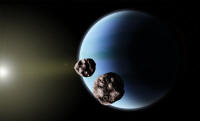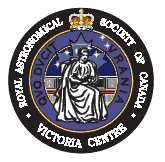 May
11, 2011 - Wide Binaries in the Kuiper Belt - Alex Parker, fourth-year
doctoral student in Astronomy, University of Victoria
May
11, 2011 - Wide Binaries in the Kuiper Belt - Alex Parker, fourth-year
doctoral student in Astronomy, University of Victoria
Outside the orbit of Neptune lies a region of the Solar System filled with
icy bodies kept in deep-freeze since the era of planet formation. This
region, called the Kuiper Belt, holds valuable information about the early
and ongoing history of the Solar System. By determining the orbits,
composition, and collisional histories of the objects in the Kuiper Belt, we
can better understand the mechanisms which governed planet formation and the
migration of the giant planets. A special class of Kuiper Belt objects orbit
as pairs; these binary systems are particularly rich troves of information,
and I will show how they answer some questions about the history of the
outer Solar System while at the same time they raise new ones about the
mechanisms of planet formation.
Presentation (6Mb pdf) - slides
of presentation and embedded links to animations. The animations can also be
found here.
Bio: After completing his Bachelors in Astronomy and Physics
at the University of Washington, Alex now attends the University of Victoria
as a fourth-year doctoral student in Astronomy. His research interests
revolve around the formation and evolution of planetary systems: Asteroid
and Kuiper-Belt Object dynamics and surface processes, detection and
characterization of extrasolar planetary systems and protoplanetary disks,
and planetary geology. Currently he is finishing his doctoral thesis on the
dynamics of binary systems in the outer Solar System, and after defending
his thesis this summer he will be heading to the Harvard-Smithsonian Center
for Astrophysics to help locate a second target for the New Horizons
spacecraft to visit after its rendezvous with Pluto in 2015.
Alex
Harrison Parker - Astronomy - Science
Supernova Sonata - a high
definition video created from CFHT images,
and sounds generated from
supernovae parameters

